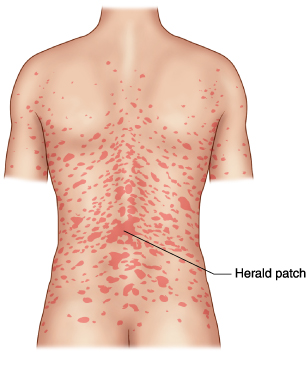Herald Patch Pityriasis
Posted By admin On 13.09.19Pityriasis rosea usually starts with a pink or tan oval area (sometimes called a herald or mother patch) on the chest, stomach, or back.
By James Heilman,MD (Own work) , is a common, itchy rash that resolves on its own. The rash begins with a herald patch, pictured above.
The herald patch is a single 2 to 10 centimeter round or oval-shaped lesion that most often appears on the trunk and resembles . Within a few days, smaller lesions appear mainly on the trunk or wherever the herald patch is located, but they can also spread to the arms, legs, and face. Lesions can continue to spread several weeks after the herald patch first appeared.
Source: http://www.mayoclinic.org/diseases-conditions/pityriasis-rosea/basics/definition/con-20028446. Photos of the Common Skin Condition. This is what pityriasis rosea looks like when the full rash has broken out. Lesions start to appear around the herald patch and can spread to the arms, legs, and face.
The lesions tend to be oval-shaped with thin, tissue-like scales that cover them, and they can be itchy. Lesions are salmon-colored and relatively discrete on light skin; on dark skin they are hyper pigmented. In most cases, a pityriasis rosea outbreak will clear up in 6 to 8 weeks, but it can persist for up to 5 months or more. Photos of the Common Skin Condition. Pityriasis rosea most often takes hold on the trunk. Studies that have investigated the skin condition's potential viral or bacterial origins are inconclusive, and the cause for pityriasis rosea is unknown.
In some cases, the rash is preceded by a recent infection with fever, fatigue, headache and sore throat. Pityriasis rosea tends to occur most often in colder months, and it occurs in all ethnicities. Only 2 percent of those who have had pityriasis rosea will have a recurrence.
Pityriasis rosea is an acute, self-limiting skin condition. A primary plaque ('herald patch') is followed by a distinctive, generalised itchy rash 1-2 weeks later. The rash typically lasts for approximately 5-8 weeks. Lesions are typically oval, dull pink or tawny and appear in a 'Christmas tree' distribution, usually on the trunk and the upper arms and legs. Aetiology The cause is unknown but it is believed to be infective in origin due to factors such as seasonal and geographical clustering. No bacterium, virus, or fungus has been isolated as a cause but human herpesviruses 6 and 7 may play a role.
Pityriasis rosea-like drug eruptions have been associated with numerous medications, including:. Angiotensin-converting enzyme inhibitors. Antibiotics (such as metronidazole) and antifungals (such as terbinafine). Non-steroidal anti-inflammatory drugs (NSAIDs). Antidepressants and anxiolytics, such as nortriptyline, bupropion and barbiturates.
Lamotrigine. Omeprazole. Biologics such as imatinib, adalimumab and etanercept. Clinical features. There may be prodromal symptoms (eg, malaise, nausea, anorexia, fever, joint pain, lymph node swelling and headache) that precede the appearance of the herald patch.
Pruritus (may be intense) is thought to occur in about half of cases. The rash begins with a herald patch in 40-76% of cases. The herald patch measures 2-5 cm in diameter and is oval or round with a central, wrinkled, salmon-coloured area, separated from a dark-red peripheral zone by fine scales. The herald patch is usually located on the trunk but may be seen on the neck or extremities. The secondary rash is symmetrical and localised, predominantly to the trunk, neck and proximal extremities. The lesions of the secondary rash are small versions of the herald patch, with the two red zones separated by a scaling ring.
They are distributed in a 'Christmas tree' pattern. In some cases, the herald patch is either absent or confluent with the other lesions. In others, there are multiple herald patches.
Variant presentations include peripheral distribution of the rash; facial involvement may be seen in children. Skin lesions may also be large, urticarial, vesicular, pustular, and purpuric, and resemble erythema multiforme. Hypopigmentation and hyperpigmentation of affected skin may follow the inflammatory stage. Oral lesions are rare but may occur - eg, erythematous plaques and ulcers. Management Pityriasis rosea is a self-limiting disease. Treatment is symptomatic and only if required. Reassure the person that the rash will disappear on its own but that it may take a few weeks to do so.

Explain that new areas may be affected by the rash for up to six weeks. Also reassure that it is not contagious. There is no convincing evidence of efficacy for any treatments used. For pruritus the following may be tried:. Emollients. Topical corticosteroid, with the potency depending on the severity of the itch. Topical menthol.
A sedative antihistamine at night such as hydroxyzine or chlorphenamine. Referral Refer to a dermatologist if:.
The rash persists for more than three months. Itch is severe. Diagnosis is not clear. Although the evidence of efficacy is not yet clear, phototherapy is often used in secondary care. Prognosis.

Herald Patch Dermatology

The eruptions are self-limiting and usually disappear gradually in 2-12 weeks, without any treatment. However, they can take up to five months to disappear in some cases. New skin lesions may continue to appear in the first 2-6 weeks. After lesions have disappeared, there may be some darkening or lightening of the affected skin for several months.
Herald Patch Pityriasis
It typically heals without scarring. Most people who have pityriasis rosea will not have another attack during their lifetime; the risk of recurrence is 2-3%.